How To Use PIA's SOCKS5 Proxy: Setup Guide for 2025
Setting up Private Internet Access’ (PIA's) SOCKS5 proxy can be challenging due to authentication errors and connection issues. Many users struggle with configuring the correct credentials, choosing optimal ports, and maintaining stable connections. Plus, the proxy requires a separate username and password from your VPN account, which adds another layer of complexity.
How do I enable and use PIA’s SOCKS5 proxy? The easiest way is through PIA’s own VPN app. It lets you connect to a VPN server using the SOCKS5 proxy for better speeds while still keeping VPN protection. However, if you're willing to trade security for faster performance, you can take the manual route — though it’s a bit more hands-on.
I’ve outlined both methods for using PIA’s SOCKS5 proxy, including how to set it up for torrenting, which other VPNs offer it, and how to troubleshoot common issues.
How To Set Up PIA's SOCKS5 Proxy
PIA gives you the flexibility to configure its SOCKS5 proxy either manually or through its apps. This approach works well for both tech-savvy users who like more control and those who’d rather keep things simple. Knowing how both options work can help you pick the setup that fits your comfort level and what you need it for.
In-App SOCKS5 Proxy Configuration
- Download and install the PIA app. Visit privateinternetaccess.com and choose the version for your device.
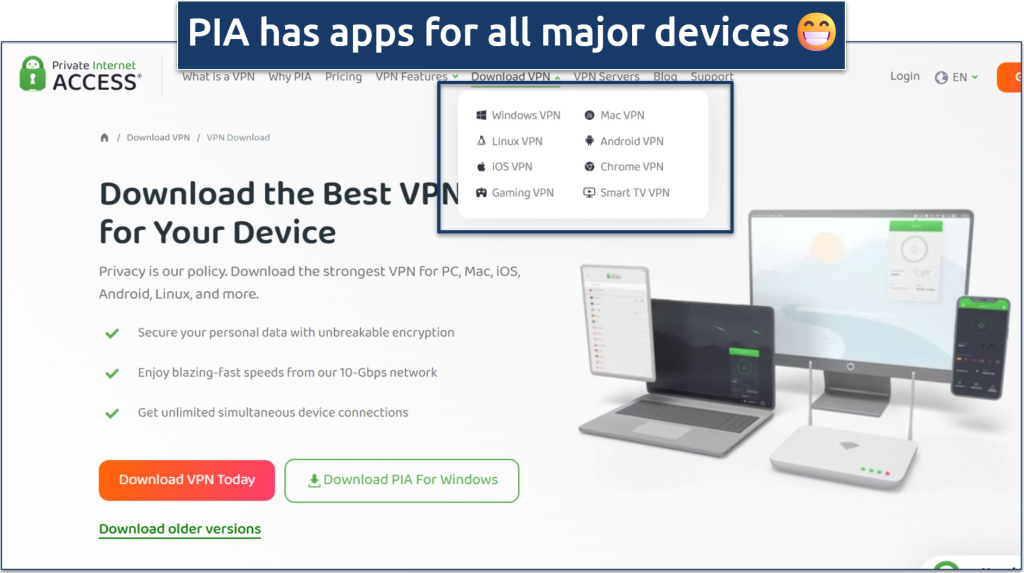 Setting up PIA took me less than 5 minutes
Setting up PIA took me less than 5 minutes - Generate SOCKS5 credentials. Log in to your account, head to the Downloads section, and scroll down to the SOCKS tab. Click Regenerate to get a unique username (starting with “x”) and a random password. Regular VPN credentials won’t work with the SOCKS5 proxy.
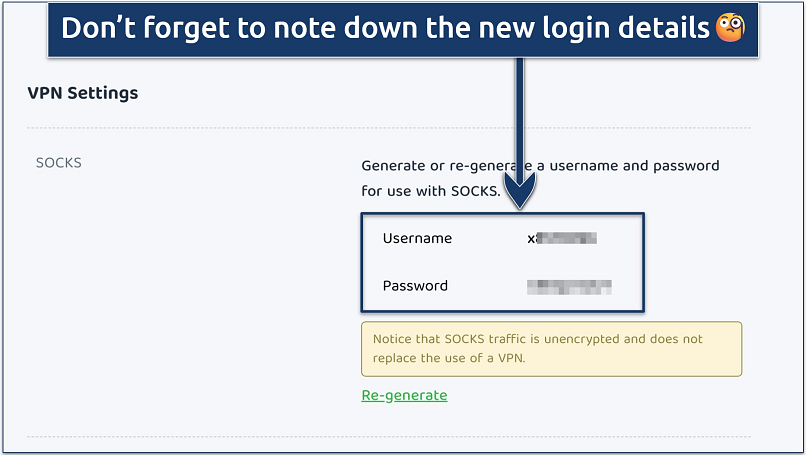 You can regenerate the login details anytime
You can regenerate the login details anytime - Access the proxy settings in the app. Open the PIA app, click the three dots (menu icon), go to Settings, and then navigate to Multi-Hop.
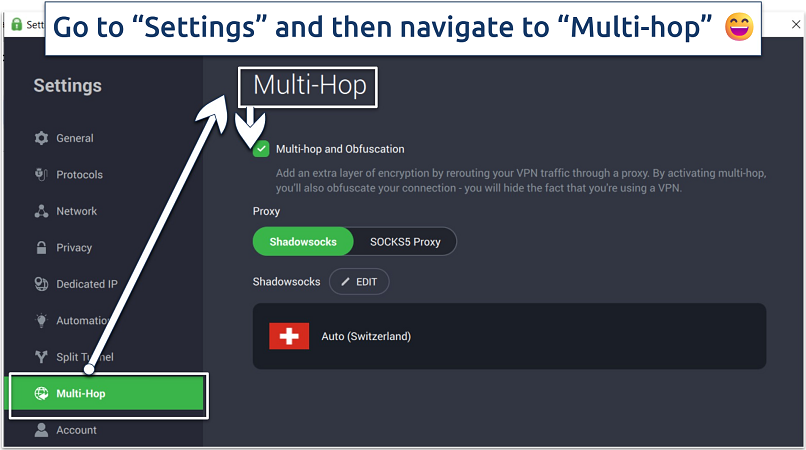 Make sure Multi-hop and Obfuscation are turned on
Make sure Multi-hop and Obfuscation are turned on - Configure PIA’s SOCKS5 Proxy.
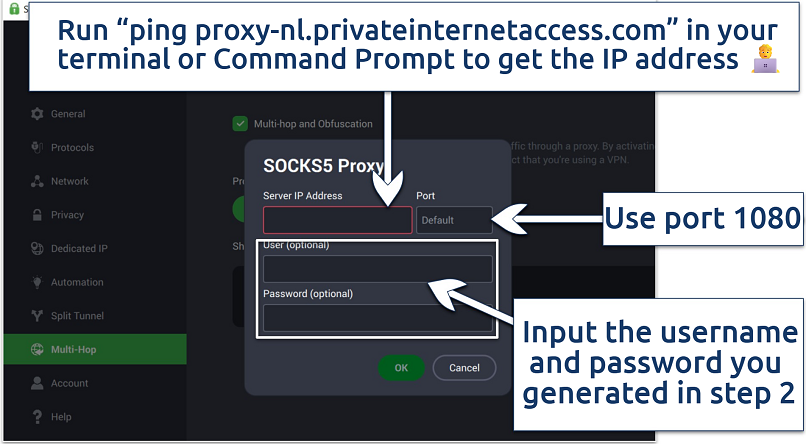 Double-check that all fields are entered correctly to avoid connection issues
Double-check that all fields are entered correctly to avoid connection issues
Pro Tip. PIA indicates the username and password are optional, but I’d really suggest filling them in. I skipped them at first, and every time I tried to connect, I got a connection error. Once I added the login details, everything worked smoothly. - You’re now using the SOCKS5 proxy. Once you click OK, return to the main screen of the PIA app, choose a server, and click the large power button.
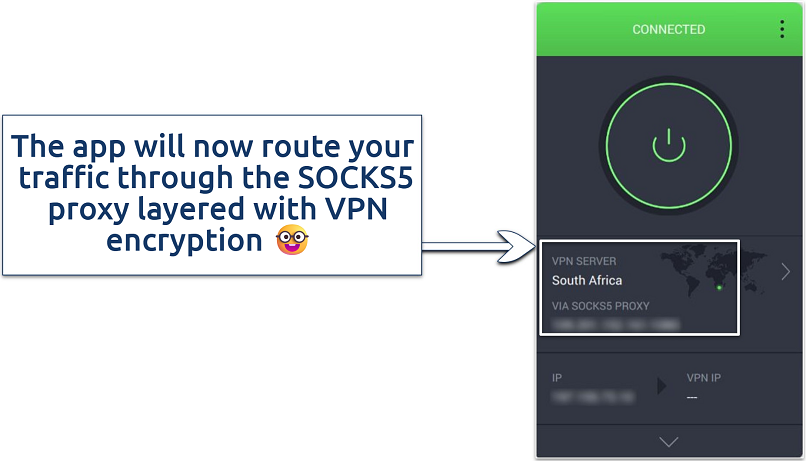 Every connection I tested using the SOCKS5 proxy was stable
Every connection I tested using the SOCKS5 proxy was stable
Pro Tip. Connecting to a nearby server and keeping the number of simultaneous connections low is recommended to boost the performance of your SOCKS5 proxy. Switching between TCP and UDP modes can also help — PIA actually suggested that during a connection hiccup I experienced, and it did the trick. Check out our guide on TCP and UDP to see which one to prioritize when using PIA’s SOCKS5 proxy. - Verify your connection. You can do this using a reliable IP lookup tool.
 I recommend choosing nearby servers for fast speeds and stable connections
I recommend choosing nearby servers for fast speeds and stable connections
Manual SOCKS5 Proxy Setup
Configuring it this way improves speed since there's no encryption overhead. Many apps and devices offer SOCKS5 support within their settings or preferences. For example, in Deluge, you can enable SOCKS5 with authentication for better security. In browsers, configure these settings in the network or proxy section of your preferences or settings.
- Generate your SOCKS5 credentials. Follow the simple steps above to complete this in just a few clicks.
- Obtain proxy server details. Use the domain proxy-nl.privateinternetaccess.com and ping it to find its IP address. For the port field, enter 1080. Refer to Step 4 above for more details.
- Configure your device. Here’s how to properly set it up on your computer.
Windows:
- Go to Settings > Network & Internet > Proxy.
- Under Manual proxy setup, enable Use a proxy server.
- Enter the IP address and port number.
- Save the settings.
macOS:
- Open System Settings > Network.
- Select your network service and click Details.
- Navigate to Proxies, enable SOCKS5, and input the proxy details.
- Click OK.
Linux:
- Access Settings > Network.
- In the Network Proxy section, choose Manual.
- Enter the proxy IP and port. Changes will be saved and applied when you close the window.
- Verify your connection. A successful connection will show a Netherlands IP address since PIA's SOCKS5 proxy servers are located there. An IP lookup tool comes in handy here.
- Enable additional security. Configure proxy-specific security settings in your application. For torrent clients, enable options like use proxy for hostname lookups and use proxy for peer connections to prevent IP leaks. For browsers, activate WebRTC protection to stop browser-level leaks that could expose your real IP address.
In-App vs Manual SOCKS5 Setup: Which Is Better and Safer?
Each option offers its own balance of speed, security, and ease of use. If speed matters most to you, the manual approach can be a bit challenging to set up, but it will get you the best speeds. However, if protecting your online activity from hackers and your ISP matters more, the in-app option provides the benefits of VPN protection.
VPNs keep you safe online by encrypting your data, and PIA even lets you switch between encryption levels — AES 256-bit and AES 128-bit. The 128-bit option is a bit less secure but can help speed up downloads and smooth out streaming. To activate, go to Settings > Protocols, and select AES-128 (GCM).
How To Use PIA's SOCKS5 Proxy for Torrenting
PIA's SOCKS5 proxy works well with popular torrent clients, offering good speeds without the overhead of full VPN encryption. Here's how to set it up on uTorrent (other clients have similar processes).
uTorrent Configuration
- Access Preferences > Connection.
- Select SOCKS5 under Proxy Type.
- Enter PIA's proxy details and credentials.
- Check Disable connections not supported by proxy.
- Enable Resolve hostnames through proxy.
However, we’d always recommend using a VPN for torrenting to hide your activities from hackers and internet service providers (ISPs).
Troubleshooting PIA's SOCKS5 Proxy
What can I do if my PIA SOCKS5 proxy isn’t working? Connection problems or authentication errors can sometimes disrupt your browsing experience. Here's how to fix the most common issues:
Common Connection Issues
- Connection timeouts. When your proxy connection keeps timing out, regenerate your SOCKS5 credentials in the PIA control panel. Old or invalid credentials often cause this issue.
- Random disconnections. Switch to a different port number if you experience frequent drops. PIA's proxy works best with port 1080, but ports 9150 and 9051 are good alternatives.
- DNS leaks. Make sure your application is configured to route DNS requests through the proxy. For browsers, enable the Proxy DNS when using SOCKS5 option in connection settings.
- Port conflicts. Check if another application is using your selected proxy port. Use the command prompt (netstat -an) to identify and resolve port conflicts.
Authentication Problems
Authentication failures are usually caused by incorrect credential format or expired passwords. Try these solutions:
- Double-check credentials. Your SOCKS5 username starts with "x" and is different from your VPN login. Copy-paste to avoid typos.
- Clear stored passwords. Remove any saved proxy credentials in your applications and re-enter them manually.
- Reset proxy password. Generate new SOCKS5 credentials in your PIA account if authentication consistently fails.
SOCKS5 vs VPN: Which Should You Use?
SOCKS5 proxies and VPNs serve different purposes, with each offering unique advantages for specific use cases:
| SOCKS5 Proxy | VPN | |
| Security | Basic authentication without encryption | Full traffic encryption with multiple security protocols |
| Speed | Generally faster due to less overhead | Slightly slower due to encryption |
| Use Cases | Ideal for torrenting, gaming, web scraping, and bypassing basic restrictions | Better for overall privacy, bypassing network blocks, and safely using public WiFi |
| Setup | Requires manual configuration for each application | System-wide protection with one click |
FAQs on Setting Up PIA's SOCKS5 Proxy
Is a SOCKS5 proxy faster than a VPN?
SOCKS5 proxies are generally faster than VPNs since they don't encrypt your traffic. Without encryption overhead, SOCKS5 connections have less latency and higher speeds. During our tests with PIA's SOCKS5 proxy, we saw only a 5% speed reduction compared to 15-25% with a full VPN connection.
However, this speed advantage comes at the cost of security. While SOCKS5 masks your IP address, it doesn't protect your data from surveillance or attacks like a VPN does. For activities requiring both speed and security, I recommend using PIA's SOCKS5 proxy within the VPN app.
Why does my PIA SOCKS5 proxy keep disconnecting?
Your PIA SOCKS5 proxy likely keeps disconnecting due to authentication and connection issues, such as invalid credentials or port conflicts. The good news is, most of these problems are pretty easy to fix.
Can I use a SOCKS5 proxy and a VPN together?
Yes, it’s possible to use a SOCKS5 proxy and a VPN together. In fact, combining them can offer the best of both worlds — faster speeds from the proxy and the strong encryption and privacy of a VPN. PIA’s built-in SOCKS5 support makes it even easier by letting you run both through the same app, saving you the hassle of setting them up separately.
Is PIA’s SOCKS5 proxy safe?
PIA’s SOCKS5 proxies provide basic IP masking but lack encryption and other security features. While PIA's SOCKS5 service uses secure authentication to prevent unauthorized access, it doesn't protect your actual data like a VPN does. Your traffic remains visible to your ISP and potentially to others on the network.
For activities requiring privacy and security, like banking or accessing sensitive information, I recommend using PIA's VPN instead of its proxy service. The SOCKS5 proxy is best suited for tasks where speed matters more than security.
Can I use PIA's SOCKS5 proxy without the VPN?
Yes, PIA's SOCKS5 proxy works independently of its VPN service. You only need an active PIA account and separate proxy credentials generated from your account dashboard. This allows you to use the proxy in applications that support SOCKS5 without installing the VPN client. I regularly use the proxy alone for tasks requiring faster speeds but not full encryption.
What's the best configuration for PIA's SOCKS5 proxy? That depends on your system, so try both TCP and UDP settings. Bomberbot reports that PIA’s proxy servers have 10 Gbps connections with 99.9% uptime2, ensuring fast and reliable connections.



Please, comment on how to improve this article. Your feedback matters!